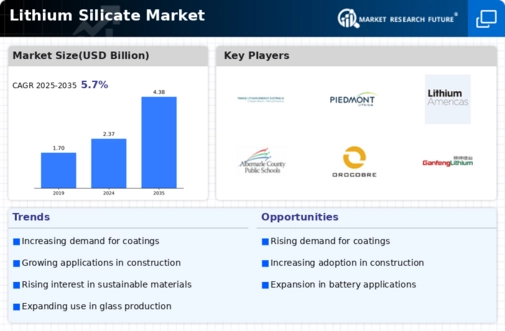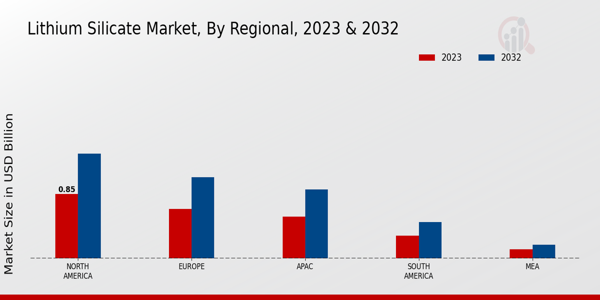Market Growth Projections
The Global Lithium Silicate Market Industry is projected to experience substantial growth over the coming years. With a market value anticipated to reach 2.37 USD Billion in 2024 and 4.38 USD Billion by 2035, the industry is on a promising trajectory. The compound annual growth rate (CAGR) of 5.73% from 2025 to 2035 indicates a robust expansion phase, driven by various factors such as increasing demand for sustainable materials and advancements in production technologies. This growth reflects the broader trends in construction and manufacturing sectors, where the adoption of high-performance materials like lithium silicate is becoming increasingly prevalent.
Expansion in the Construction Sector
The Global Lithium Silicate Market Industry is significantly influenced by the expansion of the construction sector, particularly in emerging economies. As urbanization accelerates, the demand for high-performance construction materials rises. Lithium silicate is increasingly favored for its ability to enhance the strength and longevity of concrete, making it a preferred choice among builders and contractors. This trend is expected to contribute to the market's growth, with projections indicating a value of 4.38 USD Billion by 2035. The integration of lithium silicate in construction practices not only improves material performance but also aligns with modern architectural demands.
Growing Awareness of Concrete Durability
The Global Lithium Silicate Market Industry benefits from the growing awareness of concrete durability among construction professionals and end-users. Lithium silicate is recognized for its ability to enhance the durability and lifespan of concrete structures, which is increasingly crucial in regions prone to harsh environmental conditions. As stakeholders prioritize long-term performance and maintenance cost reduction, the adoption of lithium silicate solutions is likely to rise. This trend not only supports the market's growth but also aligns with broader industry goals of improving infrastructure resilience. The increasing focus on durability is expected to further solidify lithium silicate's position in the market.
Technological Advancements in Production
Technological advancements in the production of lithium silicate are poised to drive the Global Lithium Silicate Market Industry forward. Innovations in manufacturing processes enhance the efficiency and quality of lithium silicate products, making them more accessible to various industries. These advancements may lead to reduced production costs and improved product performance, further stimulating market growth. As the industry embraces new technologies, the potential for increased application in sectors such as automotive and electronics becomes evident. This evolution is likely to support a compound annual growth rate (CAGR) of 5.73% from 2025 to 2035, reflecting the dynamic nature of the market.
Increasing Demand for Sustainable Materials
The Global Lithium Silicate Market Industry is experiencing a surge in demand for sustainable materials, driven by the growing emphasis on eco-friendly construction practices. Lithium silicate, known for its durability and low environmental impact, is increasingly utilized in green building projects. This trend aligns with global initiatives aimed at reducing carbon footprints and promoting sustainable development. As a result, the market is projected to reach 2.37 USD Billion in 2024, reflecting a robust growth trajectory. The adoption of lithium silicate in various applications, including coatings and sealants, further underscores its potential in the sustainable materials sector.
Regulatory Support for Sustainable Practices
Regulatory support for sustainable practices is a key driver of the Global Lithium Silicate Market Industry. Governments worldwide are implementing policies that encourage the use of environmentally friendly materials in construction and manufacturing. Lithium silicate, with its low environmental impact and high performance, is well-positioned to benefit from these regulations. As more countries adopt stringent building codes and sustainability standards, the demand for lithium silicate products is likely to increase. This regulatory environment not only fosters market growth but also promotes innovation in product development, ensuring that lithium silicate remains a competitive choice in the evolving landscape of sustainable materials.









